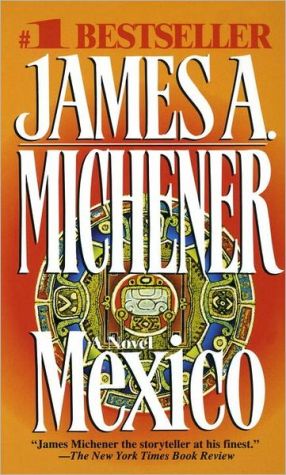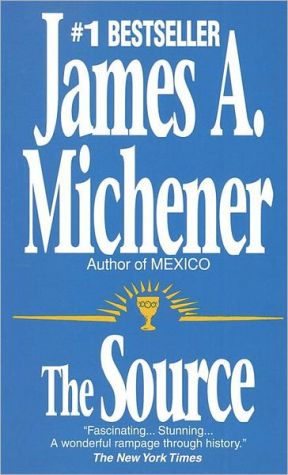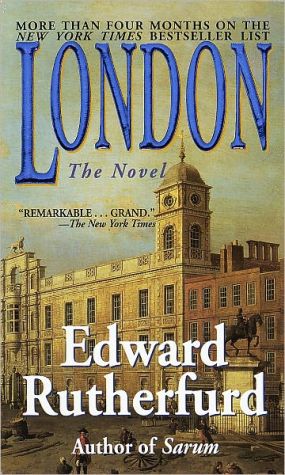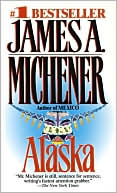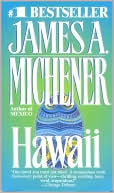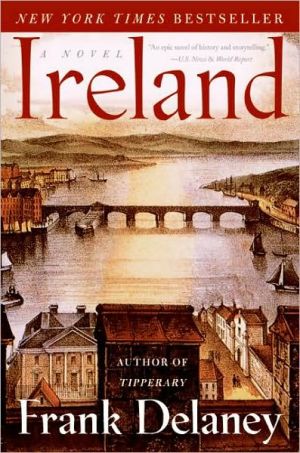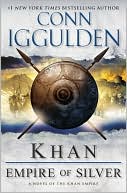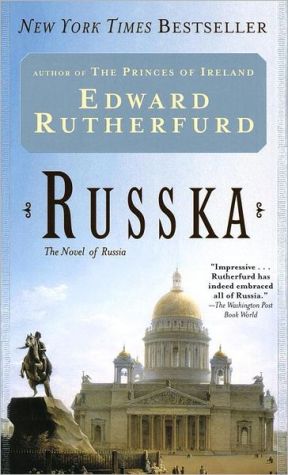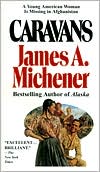Mexico
"Astounding...Fast-moving, Intriguing...James Michener is back in huge, familiar form with MEXICO."\ LOS ANGELES DAILY NEWS Here is the story of an American journalist who travels to Mexico to report on the upcoming duel between two great matadors, but who is ultimately swept up in the dramatic story of his Mexican ancestors. From the brutality and brilliance of the ancients, to the iron fist of the invading Spaniards, to the modern-day Mexicans battling through dust and bloodshed to build a...
Search in google:
"Astounding...Fast-moving, Intriguing...James Michener is back in huge, familiar form with MEXICO."LOS ANGELES DAILY NEWS Here is the story of an American journalist who travels to Mexico to report on the upcoming duel between two great matadors, but who is ultimately swept up in the dramatic story of his Mexican ancestors. From the brutality and brilliance of the ancients, to the iron fist of the invading Spaniards, to the modern-day Mexicans battling through dust and bloodshed to build a nation upon the ashes of revolution, James Michener weaves it all into an epic human story that ranks with the best of his beloved, bestselling novels.A MAIN SELECTION OF THE BOOK-OF-THE-MONTH CLUBPublishers WeeklySchematic plotting, tortilla-thin characterizations and lengthy digressions on bullfighting mar this lumbering multigenerational saga about Mexico's resilient spirit, which Michener began in 1961 and returned to 30 years later. Norman Clay, earnest American journalist born and raised in Mexico, is sent to his native city in 1961 to cover a potentially deadly showdown between two famous matadors who represent ``the two faces of Mexico, the Spaniard versus the Indian.'' This bullfight festival, the book's centerpiece, is interwoven with more interesting historical interludes in which Clay grapples with his own mixed heritage. His diverse ancestors include a 16th-century Mexican Indian queen who leads a women's revolt against human sacrifice, a Spanish scholar burned at the stake during the Inquisition, a Franciscan soldier-priest who accompanies Hernan Cortes to Mexico, a Virginia plantation proprietor who loses his wife and sons in the Civil War, and Clay's father, a silver-mine owner who participates in the Mexican Revolution. The colorful novel cuts a wide swath through history but doesn't catch fire as a personal story. BOMC main selection. (Dec.)
\ Publishers Weekly\ - Publisher's Weekly\ Schematic plotting, tortilla-thin characterizations and lengthy digressions on bullfighting mar this lumbering multigenerational saga about Mexico's resilient spirit, which Michener began in 1961 and returned to 30 years later. Norman Clay, earnest American journalist born and raised in Mexico, is sent to his native city in 1961 to cover a potentially deadly showdown between two famous matadors who represent ``the two faces of Mexico, the Spaniard versus the Indian.'' This bullfight festival, the book's centerpiece, is interwoven with more interesting historical interludes in which Clay grapples with his own mixed heritage. His diverse ancestors include a 16th-century Mexican Indian queen who leads a women's revolt against human sacrifice, a Spanish scholar burned at the stake during the Inquisition, a Franciscan soldier-priest who accompanies Hernan Cortes to Mexico, a Virginia plantation proprietor who loses his wife and sons in the Civil War, and Clay's father, a silver-mine owner who participates in the Mexican Revolution. The colorful novel cuts a wide swath through history but doesn't catch fire as a personal story. BOMC main selection. (Dec.)\ \ \ \ \ Library JournalMichener began this novel 30 years ago, put it aside, and until recently left it unfinished. Perhaps that is why it is less formulaic than most of his mammoth excursions into the history of particular localities. Mexican-born Norman Clay, a journalist for a New York publication, returns to his natal city to report on the bullfights that highlight its annual festival. This year two matadors are joined in a rivalry that could end in death. Michener dramatizes the contradictions of contemporary Mexico not only in the conflicting styles and backgrounds of the matadors but also through the many duplicities inherent in bullfighting itself. The contradictions of 1961 Mexico are the result of its history, which is personified by Norman Clay, with his heritage of Pre-Columbian Amerindians, Spanish clerics and conquistadors, rancheros and mestizos, and even an unreconstructed Virginia rebel who found sanctuary in Mexico following our Civil War. Not the usual dutiful slog through the generations but a more carefully constructed interweaving of present and past, and one of Michener's finest efforts. Previewed in Prepub Alert, 8/92.-- Charles Michaud, Turner Free Lib., Randolph, Mass.\ \ \ Donna SeamanThe publisher tells us that Michener, author of 35 big books, many graced by grand one word titles of places as storied as "Hawaii", "Poland", "Texas", "Alaska", and "Caribbean", began his epic novel of Mexico in 1961, but "put the manuscript aside 20. 20. 20. and then lost track of it." Somehow the project resurfaced and the king of epics completed it, turning out yet another ambitious and crowd-pleasing historical pageant. "Mexico" embraces and animates 1500 years of cultural conflict, romance, adventure, exploitation, and bloodshed. The narrator is Norman Clay, a successful journalist in his fifties, the product of "three radically different bloodlines": Mexican Indian, Spanish, and Virginian. Born and raised in a town in Central Mexico where his family ran a silver mine, Clay was educated in the States and hadn't been home in years. His return is precipitated by an assignment to cover the showdown between two ferociously competitive bullfighters, one of Spanish descent, the other an Indian. Michener employs this type of dichotomy throughout the book. The town itself is a symbol of dualism, sporting both a brooding prehistoric pyramid which became the site of gruesome human sacrifices and an elaborate Spanish Catholic cathedral. As the battle of the matadors proceeds suspensefully in the present, flashbacks highlighting the lives of Clay's ancestors trace the rise and fall of Mexico's great civilizations; Spain's obsession with gold, silver, and the conversion of the "pagans" to Catholicism; and the often strained relationship between Mexico and the U.S. Michener is a tireless source of homey AB>anecdotes and quick characterizations, loved by his readers for his mild teaching and absorbing entertainment.\ \ \ \ \ Kirkus ReviewsThe master of The Big National Treatment (Caribbean, Alaska, Poland, etc.) moves Mexico and Mexican history to the background of a novel about the passions, fine points, and meaning of bullfighting. Readers hoping to bone up on everything there is to know about America's new free-trading partner will find that Michener's Mexican history course ends during the Kennedy Administration when, according to Random House, the author set the uncompleted manuscript aside. Rather than drenching the book in post-Vietnam revisionism, Michener, in resuming the work, has left his story and his characters frozen in the sensibility of l961 when the peso was cheaper, there was no OPEC, no Canc£n, and, since there were no animal activists, metaphors such as bullfighting could still fly. His narrator is Norman Clay, a middle-aged magazine writer, the son of a Mexican mother and a Virginian father. After decades of absence, Clay returns to Toledo, the silver-mining city founded and reshaped by his Indian and Spanish ancestors respectively. He's there to reminisce (at length) and to write a story about an annual festival centered on three days of bullfighting. As a reporter and a relative of the town's leading family, the Palafoxes, breeders of Mexico's finest fighting bulls, Clay has an entr‚e to everything of interest going on in Toledo. Hooked up by his publisher with a party of oil-rich Oklahomans, Clay has scores of opportunities to use that entr‚e—and does, introducing the Yanquis to all the matadors, picadors, and the ghosts of the past. Anything Clay doesn't know about bulls, Leon Ledesma, the country's leading critic of the bullring and a charming, world-class cynic, does. TheOklahomans, staying up for those late Mexican suppers, learn plenty. The youngest of them, a pretty heiress just out of high school, learns just enough but not too much about Love and Nobility from the matadors. Genteel, free of epic overkill, safe for all ages, although kids may ask, "What's a bullfight?" (Book-of-the-Month Dual Selection for January)\ \
